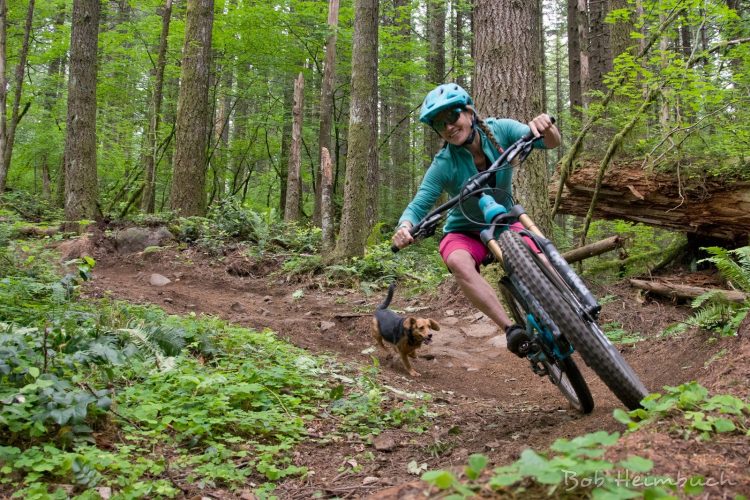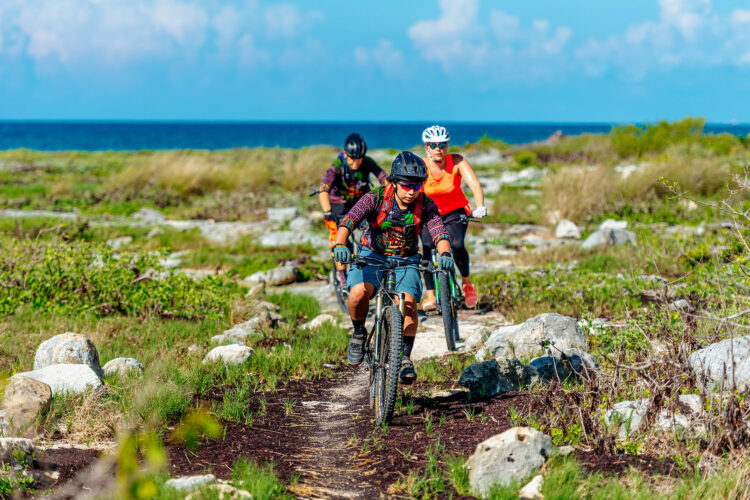
Indoor stadiums and chemically engineered turf allow athletes in soccer, tennis, American-football, and other ball-sports to compete when it rains. The turf isn’t as much fun to play on and will wreak havoc on some players’ joints, but “the game must go on.” As we know, there’s no Astroturf in the forest, and instead, we need to do a little research to find out when and where we can get muddy.
There are several factors that can make a trail more rain ready. Soil composed of loose sand and gravel and rocky trails that allow water to drain quickly are often the best options to ride after a storm. Tracks with a clay or silt base are some of the worst to ride in the rain, as your ruts and tire tracks will remain in the soil like cat paw prints in cement. In parts of Colorado, Arizona, Utah, and other states, no trail is safe from the wet-cement effect. Trail building techniques, like drainage lines and gravel beds can make a notable difference, but in some ecosystems, things will get muddy no matter how much work is done to promote drainage.
So, when is it appropriate to ride that mud? The answer depends on where you are, what the characteristics and needs of the local environment are, and what local trail builders have to say about it. The best answer to this question is to contact the trail association, or the builders themselves, or visit a nearby mountain bike shop and ask if there are trails you can ride in the rain. The folks who give their money and muscle to build the trails will always be the best to determine when they should be ridden. They often have information about soil erosion and stream degradation and know which trails hold up best through the wet months.

I lived in Eugene and Portland, Oregon, for a combined total of fifteen years, where if we didn’t ride in the mud our annual mountain bike season would have lasted two or three months. Most of the trails there are intentionally built for wet riding, and Oregon trail crews know that repairing the tread after loads of folks have ridden through the mud is part of the job. We followed the rules of riding through puddles rather than around them, minimized skidding whenever possible, and otherwise covered ourselves in a thick layer of soil a few days every week.
Occasionally you might turn up to an event on a rainy day. The onus is on the event promoter to make sure it’s okay to ride through the mud and to repair the trails afterward. There are a lot of mountain bike events staged as fundraisers for a given trail organization, wherein the builders have agreed that the funding is worth the post-event maintenance. Additionally, I have raced several events where the trails were freshly cut, and the promoter intentionally planned a race in the rain to better “bed in” the new tracks. This requires a lot of post-race work on the promoter’s part but might save some digging on the front end. These events packed our bikes with heavy mud from the recently cut singletrack, and it’s certainly not an ideal way to open a new trail in every environment, but it is still the way they do things at those events today.
I once rolled up to a trailhead for a ride, and
-Singletracks editor, Jeff Barber
the trails were completely dry since it hadn’t rained in a week. As my
buddies and I unload our bikes, one of the park workers came up to us and
told us that the trails are closed because it might start raining later in the
day and we could be riding back to the car on wet trails.
Inevitably, we will all find ourselves caught in an unannounced downpour at some point, possibly while riding one of those kitty-paws-on-wet-cement trails, and we’ll have to slog through the slop to get home. A good move, in that case, would be to volunteer for the next trail maintenance day, whether on that particular trail or any other that needs work. Putting the energy into improving and maintaining any trail is beneficial to our greater mountain bike community, even if it’s a track that you don’t ride.

Apart from repairing damaged tracks, the best thing we can do to keep trails in good shape through the muddy season is to inform ourselves. Ask folks where the best wet riding is. You may even end up with new riding partners as a result, which is always a good thing.



















